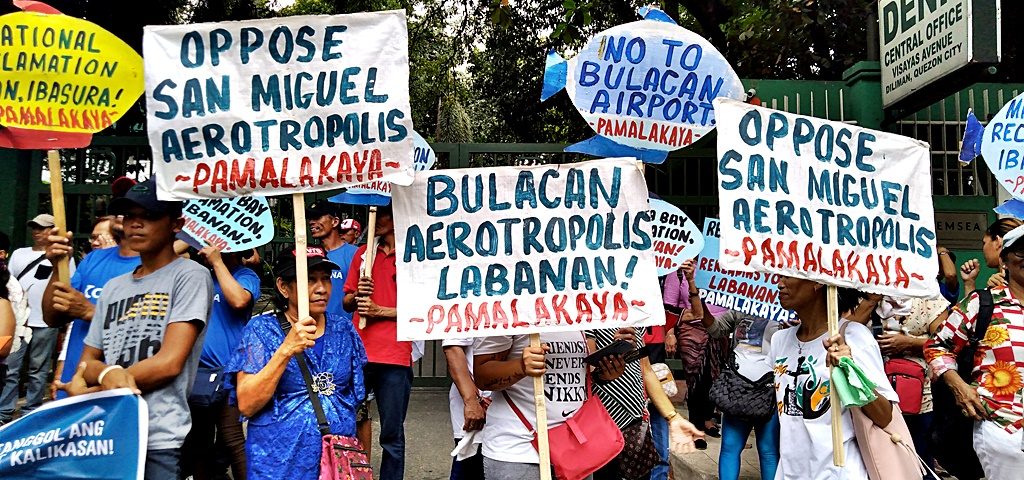SMC’s tree-planting won’t absolve them from their crimes against the environment and the people — groups
Manila, Philippines — Environmental and fishers’ groups are not convinced with the mangrove planting of Ramon Ang’s San Miguel Corporation (SMC), in Bulacan, which they said in a joint statement “won’t absolve“ the food and beverage giant from their “crimes against the environment and the people”.
On July 29, SMC, in partnership with the local government of Hagonoy, Bulacan, has started planting 25,000 mangroves on 10 hectares of coastal area in Hagonoy, Bulacan, which is part of the target 190,000 mangroves to be planted over 76 hectares in Bulacan and neighboring provinces.
“While this may sound good news to marine conservationists, this, in fact, won’t absolve San Miguel Corporation from their crimes against the environment and the coastal communities in Bulacan,” Jerwin Baure, Spokesperson of scientist group AGHAM Diliman said in a statement on Friday.
Despite planning to plant thousands of mangrove trees, AGHAM Diliman said, SMC still wants to push through with its Bulacan Aerotropolis project, a massive reclamation project which will reclaim an estimated area of around 2,500 hectares.
“This reclamation project will destroy many patches of mangrove forests in Bulacan, and this will have grave ecological consequences,” Baure added.
In 2018, AGHAM Diliman added, around 600 mangrove trees have been cut down in Brgy. Taliptip, Bulakan, Bulacan, and there have been many incidents of human rights violations in the affected communities perpetuated by the military and SMC personnel.
For its part, the fishers’ group Pambansang Lakas ng Kilusang Mamamalakaya ng Pilipinas (PAMALAKAYA) said SMC’s mangrove planting “does not make the giant corporation a pro-environment and pro-conservation”.
“San Miguel Corp. is a notorious environmental plunderer, and lest we forget, a land grabber as well. Aside from the international aerotropolis in Bulacan, SMC is threatening to displace at least 3, 000 fishing and farming families in Sariaya, Quezon to construct a dirty coal-fired power plant,” Fernando Hicap, PAMALAKAYA National Chairperson said in a statement.
“It is not easy to replace decades-old mangrove forests. As the airport’s construction commences this October, cutting of more mangrove trees is inevitable, an act which even the DENR claims is entirely prohibited under existing environmental laws,” Baure lamented.
AGHAM Diliman and PAMALAKAYA explained that one of the reasons for the total logging ban on mangrove trees is the characteristic slow growth rate of most mangrove species that makes them really hard to replace. The extensive root system of mangroves that serves as protection for communities from floods, erosions and storm surges took decades to be established.
Young seedlings or propagules of mangroves with no extensive root system yet are prone to harsh conditions in the coast (e.g. winds, currents and barnacle infestation). This hampers their growth and may result to high mortality rates prior to maturity.
“This means that it will take another set of decades to replace the existing mangroves, thus leaving coastal communities more vulnerable to hazards, and the ecosystems altered for years,” Baure, also PAMALAKAYA’s resident fisheries expert explained.
The role of mature mangrove forests in mitigating climate change will also be gravely affected by the airport project. The amount of carbon trapped by mature mangrove trees and the underlying sediments will be altered by the construction, and cannot be replaced immediately by these planted seedlings.
“The time is running out for our vulnerable communities due to the hazards brought by climate change, and in this context, no wide-scale planting activity can justify a wide-scale destruction of existing mangrove forest,” decried Baure.
Given this pandemic, AGHAM Diliman called, the government should be aware of the grave consequences of destroying the natural habitats and disturbing the wildlife present in our archipelago.
Manila Bay Area, particularly the entire coast of Bulacan is a Key Biodiversity Area (KBA) where mangroves host a wide array of migratory birds. However, this wildlife will definitely be affected by the loss of mangrove cover and the actual airport activities.
In a statement released by SMC, Ramon Ang, President and COO, said that the mangrove planting activity is part of the airport development master plan and addresses flooding and environmental concerns. These concerns are supposedly included in the environmental impact statement (EIS) submitted to the DENR. The EIS is supposedly a public document, yet the environment agency has denied its access to environmental organizations requesting for a copy. This questionable move by both the DENR and SMC raises concerns among various stakeholders as the document might have overlooked key concerns.
AGHAM – Advocates of Science and Technology for the People calls on the DENR to release the EIS of the project for transparency’s sake. We urge the environment agency to carefully review and reconsider the project, and ultimately uphold their mandate on protecting and conserving the environment.
“This pandemic should be a wake-up call for the authorities to be more focused on conservation schemes that will benefit the community welfare while ensuring environmental integrity, rather than taking the side of big corporations’ money-making schemes guised as development,” AGHAM-Diliman and PAMALAKAYA ended a joint statement. ###
